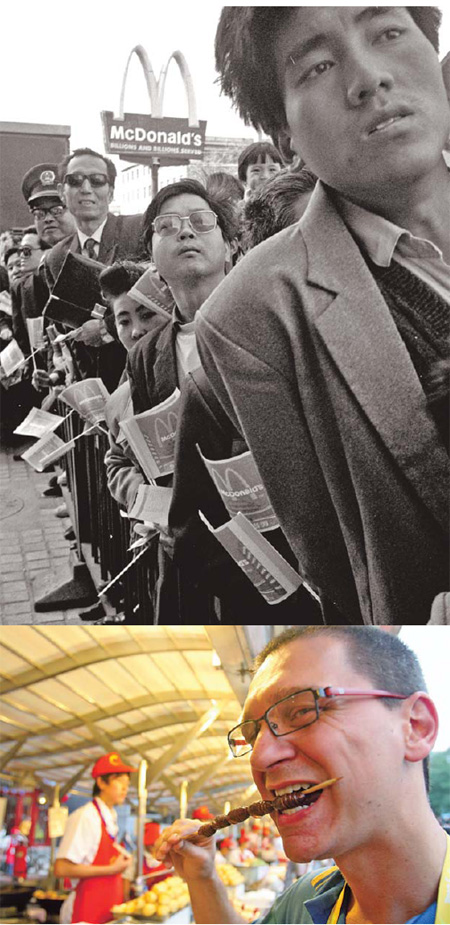Food
Chasing changing palates
By Ye Jun (China Daily)
Updated: 2011-06-01 08:25
 |
Large Medium Small |
|
Top: Citizens queue at the gate of a McDonald's restaurant on Wangfujing Street in Beijing on April 23, 1992. The restaurant was then the largest of McDonald's outlets in the world. Above: A foreigner tries Chinese snacks in Beijing in August 2008 during the Beijing Olympic Games. Top: Wang Wenlan / China Daily; Above: Chen Xiaogen / for China Daily |

One of Bian Jiang's most vivid memories of Beijing in the 1980s was the long queues of people, waiting in the late autumn chilly wind, to buy large amounts of cabbages and sweet potatoes to take home.
Much of this produce was stored in cellars or on freezing balconies to make them last through the winter. The cabbages would sometimes be preserved with salt, or pickled. Sweet potatoes were often dried.
With no greenhouses or refrigerators, vegetables were seasonal.
"You would only see beans, cucumbers and tomatoes in summer, and cabbages, potatoes and carrots in winter," says Bian, deputy secretary-general of the China Cuisine Association.
Bian, now 57, was a sales clerk at a State-run food store when he got married in 1981. For him, his busiest time was the start and end of months when food coupons, or liangpiao, were distributed.
"With money alone you could not buy grain," says Bian, adding that the coupons were needed for all staple foods as well as cooking oil, fish, meat and eggs.
As a sales clerk, Bian's quota in 1981 was 17.5 kilos, or 35 jin, a month. In 1985, he changed jobs and joined China Business News as a journalist, and his quota changed to 31 jin.
"The markets had more variety to offer by then, and therefore people needed less staple foods," he says.
The food coupons, which were introduced in 1955, became a symbol of China's planned economy.
With China opening up and better availability of staple foods, the coupons were abolished in 1993.
That period also saw the entry of foreign fast-food chains, with KFC opening its first outlet in China in 1987 (in Beijing) and McDonald's in 1990 (in Shenzhen), an event Bian attended as a journalist.
"At first we didn't feel the impact of the two fast-food giants. But that influence has become bigger and bigger," he says.
"It was only after people's income grew, and time became limited, that people started to understand the concept of fast food," Bian says. "China's fast-food industry only took off in the past 10 years."
Bian said restaurant turnover in China has been growing at a rate of 15 to 17 percent yearly for the past 20 years. Last year, the industry turned over 1,870 billion yuan ($288 billion), with fast-food sales accounting for 40 percent.
Around the middle of the last century, most of Beijing's restaurants - such as Quan Jude, Bian Yi Fang and Feng Ze Yuan - were all State-owned. And there were hardly any foreign restaurants.
The first was the Moscow Restaurant, which opened in 1954 at the Beijing Exhibition Center and became a fashionable haunt. Maxim de Paris opened in 1979 and amazed Beijingers with its dcor - and incredible prices.
But in 1980, individuals began to open restaurants offering not only the Shandong-style cuisine common in Beijing, but food from other parts of China. Tastes began to change dramatically.
One of the first to do so was Yue Bin Restaurant in Beijing's Cuihua Hutong in 1980, opened by Beijinger Liu Guixian and her husband.
What followed was a growing industry that began to cater to tastes of people from outside Beijing, with cuisine from Sichuan, Hunan, Guangdong (Cantonese), Jiangsu, Zhejiang, Shanghai and Anhui becoming popular.
Chong Zhanming, who heads a team of judges to determine professional skill levels in Beijing's food business, says in the 1980s, meat was scarce and people ate mostly vegetables.
Beijingers preferred fatty Peking roast duck, and used pork fat to extract the oil for frying.
But later as meat became readily available and made up a bigger proportion of people's diet, blood sugar and fat levels started to climb. Now, says Chong, people "tend to eat less fatty meats and foods low in sugar and fat".
Chong says that from the 1980s, people from outside Beijing, who started to come to the city to look for work, "brought different tastes and influenced the direction of the restaurant market".
With city residents hungry for different cuisine, restaurants such as Da Dong Peking Roast Duck began to break out of the concept of cuisine styles and created Chinese fusion cuisine, Chong says. Chef Dong Zhenxiang became really good at trying new ideas and transformed Chinese cuisine, Chong says.
Dong learned food presentation from Western cuisine and infused Chinese art elements to make dishes look beautiful according to Chinese aesthetics. Many chefs have followed Dong's example and have created their own Chinese dishes.
When Li Jing, 37, returned to Beijing after living in New Zealand from 2002 to 2008, she found Beijing food to be totally different.
"Restaurants offer so much more diversity," she says, pointing out that Beijing now has a wide variety of foreign cuisine restaurants such as French, Spanish, South African, Korean, Japanese and even restaurants supported by Michelin star chefs, such as Maison Boulud and Sadler at Ch'ien Men 23.
Li - who has advanced cooking and baking certificates, as well as barista qualifications, from the Manukau Institute of Technology in New Zealand - has noticed a growing fusion between Chinese and Western cuisine.
But Bian, who has visited many countries known for their cuisine, says nothing surpasses Chinese restaurants where "eating is a pleasure".
(China Daily 06/01/2011 page50)
| 分享按钮 |
